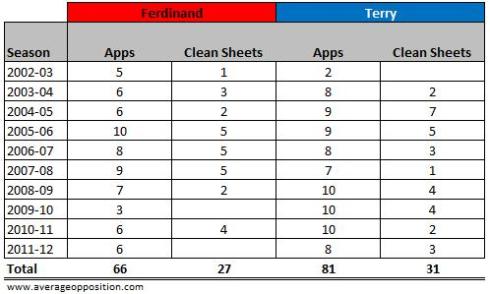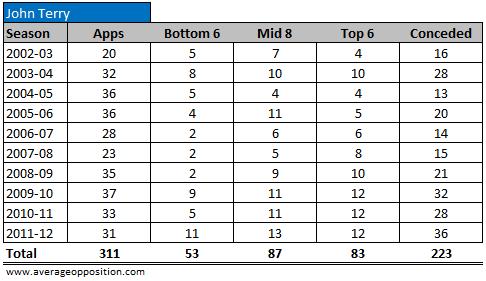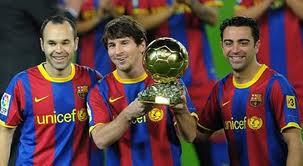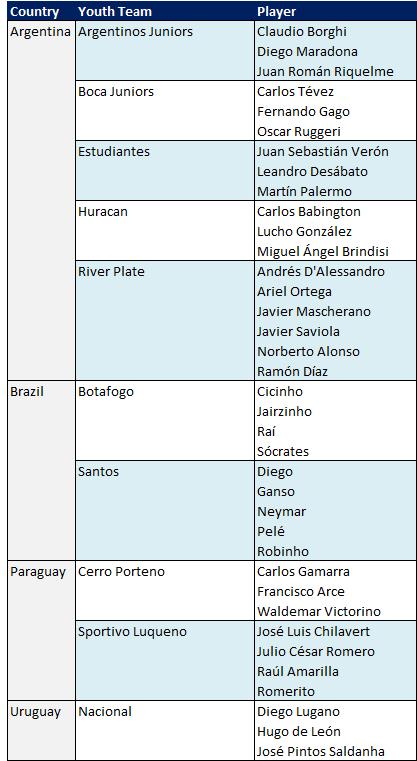Up next in the World Famous Player Comparison series is a slightly controversial one. England defenders and definitely not best friends, Rio Ferdinand and John Terry. Two of the best defenders in Premier League history, this is the first comparison of defenders, and could be the last depending on feedback….
Given the recent disharmony between Terry and the Ferdinands, this may seem a bit on the reactive side, but I’ve had this request on more than one occasion (twice) so thought I’d give it a go. Both are entering the twilight of their careers (Rio has just turned is 34, JT, approaching 32), both have been League winners and Champions League winners. Both have played at one of the biggest clubs in the world for 10 years or more, and for a long time, the two were playing alongside eachother at the heart of the England defence. With that in mind, and the added spice of club and personality clashes/rivalries, they’re ideal candidates to compare.
The Rules
Usually I’m comparing goals and assists, but in this instance the focus is all about the dirty business of stopping them. So when looking at the range and average opponent, it’ll be by goals conceded and clean sheets. The primary focus will be on Premier League stats, but there will be a look at international and cup games. The calculations can be found in the rules and workings page on the top menu, but simply enough, it’s a look at their stats but by the level of opposition.
The time period is from when Ferdinand signed for Manchester United at the start of the 2002-03 season, up until the end of 2011-12 – 10 full seasons. In that time, Terry has played 311 Premier League games to Ferdinand’s 269.
Background
Despite being born and bred in South London, Rio Ferdinand began his Football career in the prestigious West Ham academy. Initially a central midfielder, Rio was taught the art of defending under the tutelage of Tony Carr, and was hailed as the heir to Bobby Moore’s throne for club and country. With his ability on the ball, Ferdinand also played for the West Ham first team in central midfield, wing back and even up front – scoring his first senior goal in just his second substitute appearance, after his debut aged just 17. Seen as talented but unfocused, eyebrows were raised when Leeds United paid £18m for the young defender in November 2000 – both a British Record transfer and also the World Record price for a defender. But Ferdinand excelled under fellow Centre Back David O’Leary and helped a young Leeds team to the Semi Final of the Champions League later that season. Another good season later, and Ferdinand was starting for England in the 2002 World Cup, as they got to the Quarter Finals. His displays for both Leeds and England were enough for Sir Alex Ferguson to pay over £30m – making him once again the most expensive British footballer, and regaining the title of World’s most expensive defender from Lilian Thuram.
John Terry on the other hand, has been a one club man. Despite also training with West Ham as a youngster, the Barking born defender signed for Chelsea at the age of 14 after playing for famous boys club Senrab, along with the likes of Bobby Zamora, Ledley King and JLloyd Samuel. During his early years around the Chelsea first team squad, he saw his chances limited due to Marcel Desailly and Frank Le Boeuf, and subsequently found himself at Nottingham Forest on a short term loan to get first team experience under David Platt. Despite making his Chelsea debut in the 1998-99 season, Terry didn’t become a first team regular until the 2000-01 season, playing 22 league games as Chelsea finished in 6th place. The following season, Terry further cemented his place as a first team regular, playing in 33 of the 38 league games, as Chelsea once again finished in 6th place. Seen as a typical British defender, Terry made a reputation for putting his body on the line for the cause, but it his ability to pass the ball was often overlooked as a result.
Premier League
Clean Sheets
And so on to the hard numbers. First and foremost, the appearances and clean sheets by season:
Both have pretty good records with close to a one in two clean sheet rate. Ferdinand’s appearances have been slightly limited due to injury and an eight month ban for forgetfulness. Over the ten years, Ferdinand has made an average of 27 league appearances per season, and in that time, has kept an average of 12.9 clean sheets per season. In total, he’s kept a clean sheet for every 2.085 games. John Terry’s 311 appearances work out at an average of 31 games per season, with a clean sheet rate of 15.9. So on the face of it, Terry is ahead, with a clean sheet every 1.955 games.
Terry’s high of 25 in Chelsea’s title winning season of 2004-05 dwarfs Ferdinand’s 19 in 2007-08, when United won the total. In fact, Terry has kept 20 clean sheets or more in three of the ten seasons. Surprisingly, neither player has completed a full 38 game season.
So Terry’s ahead on the overall defensive stats, but in reality, both keep a clean sheet every second game – a phenomenal rate over a ten year period. But what of their quality of the opposition? Step this way.
First up (due to age and alphabet) is Ferdinand. A decent 27 clean sheets against the teams that finished in the Top 6, 65 against the Mid table teams and 37 against the teams struggling against relegation. An average ranked opponent of 11.21 over 129 clean sheets, his highest number of clean sheets against the big teams was five, which was achieved in three consecutive seasons between 2005-06 to 2007-08, with Man Utd winning the league in the latter two seasons. His highest average was in 2010-11, with 7.50 average from his eight clean sheets – of which, half were against the Top 6 teams, with Spurs (twice), Arsenal and Man City all being kept out. Tellingly, no clean sheets were kept against the Top 6 in the 2011-12 season as United lost the title on goal difference, with Ferdinand being part of the United team that lost 6-1 at home to Manchester City.
 Terry’s best season was by far and away the 2004-05 season. Keeping a whopping 25 clean sheets against an average ranked opponent of 10.12 as Chelsea went on to win the league for the first time in 50 years, breaking, posting the best defensive record in the history of the English top flight. The season after also saw a stellar defensive display from Chelsea, and Terry was partly responsible for 20 clean sheets, including five against the Top 6 teams. Last season however, saw a drop in the number of clean sheets as he posted just 9 during his 31 league appearances. This could be down to a number of things, such as off the field problems, or defensive partners. Long gone are the days of Carvalho, who has been replaced by Luiz and Cahill. As a result, the number of clean sheets have dropped significantly.
Terry’s best season was by far and away the 2004-05 season. Keeping a whopping 25 clean sheets against an average ranked opponent of 10.12 as Chelsea went on to win the league for the first time in 50 years, breaking, posting the best defensive record in the history of the English top flight. The season after also saw a stellar defensive display from Chelsea, and Terry was partly responsible for 20 clean sheets, including five against the Top 6 teams. Last season however, saw a drop in the number of clean sheets as he posted just 9 during his 31 league appearances. This could be down to a number of things, such as off the field problems, or defensive partners. Long gone are the days of Carvalho, who has been replaced by Luiz and Cahill. As a result, the number of clean sheets have dropped significantly.
So John Terry is more likely to play first and foremost, and he’s just ahead of Rio Ferdinand in terms of games per clean sheet. But……
If we take a closer look at Clean Sheets against the Top 6, taking into account Ferdinand’s appearances. Each player has finished in the Top 6 in each of the ten seasons, meaning there’s a maximum of ten appearances against Top 6 opposition. So here’s the clean sheets and appearances by player versus the best in the league:
John Terry’s clean sheet rate of one every 1.955 games becomes a clean sheet every 2.61 games, compared to Ferdinand’s clean sheet every 2.44 games. So Terry’s more likely to keep clean sheets overall, but Ferdinand did it more against the best in the league. In United’s last title winning season, he kept an impressive four in just six appearances.
Goals Conceded
Moving on to goals conceded. First up is Ferdinand again. Over the 269 Premier League games for United in the last 10 years, he’s let in on average 0.75 goals per game – comfortably under the magical 1 per game target. His best season, being the 2007-08 title win, where he let in only 21 goals in 35 games – 0.6 goals per game. The season before, he played 8 games versus the Top 6 teams, and only conceded 4 goals, whilst in 2010-11, the other Top teams only managed to score twice during his 6 games against. In total, he conceded 70 goals in 66 apearances against the best teams in the league – a number damaged by the 6-1 Manchester Derby.
Moving on to Chelsea’s Captain, on the same comparison, Terry conceded 83 goals in 81 appearances against fellow Top 6 teams – just ahead of Ferdinand’s rate. His best season against the Top 6 was in 2004-05 when just four strikes got past him and his team mates in 9 appearances. His overall goals conceded rate is 0.72 per game – almost identical to his rival’s 0.75. His best season was the phenomenal 2004-05 when just 13 goals were conceded on Terry’s watch – a phenomenal 0.36 goals per game. No wonder they won the league so comfortably.
Discipline
This isn’t taking into account the many off the field issues affecting each player, but a very quick look at the yellow/red card count in their last ten years. It’s fair to say that the records are like Chalk and Cheese in this regard. In just the Premier League games, they’ve shared 5 Red Cards – 4 of which were for Terry. Reds against Spurs (twice), Everton and Man City have cost his team as they managed just one win in the four games. Ferdinand’s one red was in the 4-3 defeat to Blackburn, that saw young up and coming midfielder David Bentley score a hat trick against United. A platform for great things…..
On the yellow cards, it’s pretty much the same story – Terry has 52 to Ferdinand’s 20 in what is in keeping with the general expectation of the players – Terry seen as a British Bulldog, win at all costs type, with Ferdinand seen as the cultured type. In all competitions, for club and country over the 10 years we’re looking at, it’s 31 yellows and 1 red for Ferdinand, and 80 yellows and 5 reds for John Terry, with the last Red costing him a place in the Champions League Final – not that he missed the celebrations.
Goals
One area where there really is no contest is at the other end of the pitch. Whilst Ferdinand scored 7 Manchester United goals in the ten years we’re looking at, John Terry scored a massive 43 in the same period. Whilst it has nothing to do with who is a better defender (Philippe Albert anyone?), it’s certainly an interesting angle, and some could use it when looking at the all round footballers. Terry can point to goals against Roma, Arsenal, Man City and Barcelona in recent years, whilst Ferdinand’s highlights in front of goal would be scoring against Liverpool in back to back seasons.
Champions League
Of course, both players have Champions League medals and both have tasted defeat in the final, so it’s worth comparing their records in Europe – both at a group stage and a knock out stage – where in theory, the opposition are better.
Once again, Terry leads the way with the overall number of clean sheets – posting 39 against Ferdinand’s 36, however, when you take into account the number of games, then Ferdinand has the fewer number of games per clean sheet at 1.94 from 70 appearances compared to Terry’s clean sheets every 2.23 games from his 87 appearances.
Champions League break down:
So in keeping with the Premier League stats, Ferdinand is more likely to keep a clean sheet in the bigger games. Terry has kept a clean sheet for every 1.7 group games in the Champions League, but just one every 3.42 in the knock out stages. Ferdinand on the other hand is pretty consistent – averaging a clean sheet every two games regardless of the stage.
Other big games
Both players have played in three league cup finals. Ferdinand has two medals, keeping clean sheets in two games, and conceding two goals in the three games, whilst Terry’s three finals have seen five goals conceded, and one win. Moving on to the FA Cup, Ferdinand has played in two FA Cup finals – keeping a clean sheet before losing on penalties to Arsenal in 2005, and the equally thrilling 1-0 defeat to Chelsea in 2007. Surprisingly, after ten years at Old Trafford, he doesn’t have an FA Cup winners medal (he was suspended when Millwall were beaten in 2004). Terry on the other hand has four winners medals in that time (to add to his 99-00 one), keeping clean sheets against Portsmouth (2008) and Man Utd in the aforementioned snorefest. Two 2-1 victories over both Merseyside clubs completed the set. So Ferdinand has three clean sheets in five domestic Cup Finals to Terry’s two in seven.
England
 So we’ve established that both are great defenders in their own right, but how we’re they together, and did they fair better with or without each other for England? Ferdinand won the first of his 81 caps in 1997 as a teenager, and even made it to the World Cup the following year as a non playing squad member. Terry would have to wait another five seasons for his first cap, and up until his recent international retirement, made 78 appearances for the Three Lions.
So we’ve established that both are great defenders in their own right, but how we’re they together, and did they fair better with or without each other for England? Ferdinand won the first of his 81 caps in 1997 as a teenager, and even made it to the World Cup the following year as a non playing squad member. Terry would have to wait another five seasons for his first cap, and up until his recent international retirement, made 78 appearances for the Three Lions.
In the last ten years, Ferdinand’s made 59 appearances to Terry’s 72 – playing alongside eachother on 34 occasions:
In terms of clean sheets, there wasn’t really much difference. Together they kept a clean sheet every 2.20 games, Ferdinand without Terry was 2.27 and Terry without Ferdinand was 2.17 – a slight edge to Terry. In terms of goals conceded, together they let in 0.82 goals per game, with Ferdinand keeping a slightly better 0.8 conceded without Terry and Terry keeping a consistent 0.82.
Once again, there’s not a great deal in it. In terms of highlights, Terry’s clean sheet against Italy in Euro 2012, compares with Ferdinand’s clean sheet against Argentina in the 2002 World Cup. In terms of goals, it’s a bit closer than their club appearances, with Ferdinand scoring three goals for England compared to Terry’s six. Interestingly though, all of Ferdinand’s have been in competitive matches, with five of Terry’s six being in friendlies (including Brazil and Germany).
The Makelele Factor
It’s hard to put an exact impact to the Chelsea clean sheets that John Terry kept, but from 2003-04 to 2007-08 Claude Makelele played the holding midfield role so well that it was renamed the Makelele role. During that time, John Terry kept 91 of his 159 clean sheets, keeping 68 in the five seasons without him. Ferdinand meanwhile had Roy Keane for his first three seasons at the club with his best defensive performances coming after the departure of the influential skipper. And it’s fair to say that he wasn’t quite as defensively disciplined as Makelele.
Conclusion
Shock Horror, I’m going to declare this one a draw. Terry was slightly more likely to keep a clean sheet, but Ferdinand was slightly more likely to do so against the best opponents. In the big games, Ferdinand had the edge in terms of both clean sheets and goals conceded (such as domestic Cup Finals and European knock out games) but Terry was much more likely to trouble the opposition by scoring. Looking at their England records, it was near identical with and without each other. There was only ever going to be one conclusion based on the stats.
So despite your view of each player as a person, no one can honestly say that they haven’t both been excellent players – perhaps two of the best in English history. Both are coming to the end of their careers now, but for those ten years, there are very few who can compare.
Cheers,
Liam





















